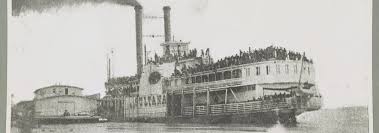The Sultana Tragedy

The Sultana Tragedy | Sultana Disaster Museum | Civil War Maritime History Helena
The Sultana Disaster stands as one of the greatest maritime tragedies in American history, yet it remains largely overshadowed by the events of the Civil War itself. On April 27, 1865, the steamboat Sultana, carrying over 2,100 passengers—mostly Union soldiers returning home after surviving Confederate prison camps—exploded on the Mississippi River near Memphis. More than 1,100 people lost their lives in what would become the deadliest maritime disaster in U.S. history, surpassing even the sinking of the Titanic in terms of loss of life within American waters. Today, the Sultana Disaster Museum in Helena, Arkansas, preserves this story and ensures that the legacy of those who perished and survived is never forgotten.
A Steamboat Bound for Tragedy
The Sultana was a side-wheel steamboat built in 1863, designed to carry about 376 passengers. However, in the chaos of the Civil War’s end, steamboats were pressed into service to transport thousands of paroled Union soldiers back to the North. On that fateful April voyage, greed and corruption played a fatal role. The owners of the Sultana sought profit by overloading the vessel well beyond capacity, cramming over 2,100 passengers on board.
The ship’s boilers were in disrepair, and though an engineer advised proper maintenance, the repairs were done hastily and insufficiently to avoid delaying departure. This negligence, combined with the dangerous overcrowding, set the stage for catastrophe.
The Explosion and Aftermath
In the early hours of April 27, as the Sultana traveled upriver against the swollen spring currents of the Mississippi, one of the boilers exploded. The force of the blast destroyed much of the vessel, causing two more boilers to rupture. Fire quickly spread across the decks, trapping many passengers. Survivors leapt into the river, where cold water and strong currents claimed even more lives. Many of the soldiers—already weakened from starvation and disease during their imprisonment at Andersonville and Cahaba—did not have the strength to swim or hold on to debris.
Of the estimated 2,100 passengers, more than half perished. The disaster struck just days after the assassination of President Abraham Lincoln, and with the nation’s attention fixed on the end of the Civil War, the tragedy faded from public memory far faster than it deserved.
Remembering at the Sultana Disaster Museum
Located in Helena, Arkansas, the Sultana Disaster Museum stands as a tribute to the lives lost and the resilience of the survivors. The museum’s mission is to educate visitors about the tragedy while placing it within the broader context of Civil War maritime history.
Exhibits and Collections
Visitors can explore a wide range of exhibits that include:
-
Recovered Artifacts: Personal belongings, fragments of the steamboat, and contemporary relics provide tangible connections to the passengers and crew.
-
Survivor Stories: Through letters, journals, and recorded oral histories, the voices of those who lived through the disaster are preserved.
-
Civil War Context: Displays explain how the war’s end, prisoner exchanges, and government contracts for steamboat transport created the conditions that led to the overcrowded voyage.
-
Maritime Technology: Models and diagrams of 19th-century steamboats and their boiler systems help visitors understand how engineering flaws contributed to the explosion.
Education and Community
The museum also serves as a center for historical research and community engagement. Educational programs invite students and scholars to study the Civil War from a maritime perspective, while annual commemorations ensure the memory of the victims is honored. By hosting lectures, reenactments, and community events, the museum connects Helena’s local history with the broader American narrative.
The Legacy of the Sultana
Though the Sultana Disaster is not as widely recognized as other historical tragedies, its legacy is profound. It reflects the dangers of greed, corruption, and negligence, while also highlighting the resilience of human survival in the face of unimaginable hardship. For the families of the soldiers—many of whom had already suffered through years of war and imprisonment—the tragedy was an especially cruel blow at the very moment when peace had been restored.
Today, the Sultana Disaster Museum in Helena keeps this memory alive, reminding us of the human cost of war, the responsibilities of those in power, and the importance of historical preservation. By walking through its exhibits, visitors not only learn about the past but also reflect on lessons that remain relevant in the present: integrity, accountability, and the value of human life.
Conclusion
The story of the Sultana is more than just a maritime disaster—it is a reflection of the turbulence of post-war America, the human desire to return home, and the devastating consequences of negligence and corruption. The Sultana Disaster Museum in Helena, Arkansas, stands as a guardian of this history, ensuring that the lives lost are remembered and that their stories continue to shape our understanding of Civil War maritime history.
Visiting the museum is not only a journey into the past but also an invitation to honor resilience, mourn tragedy, and learn from history.